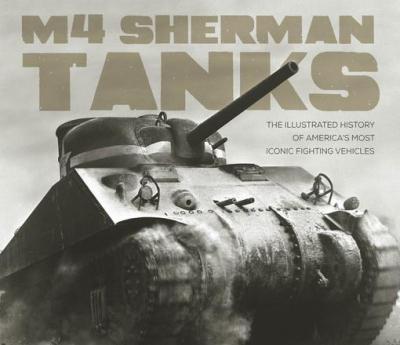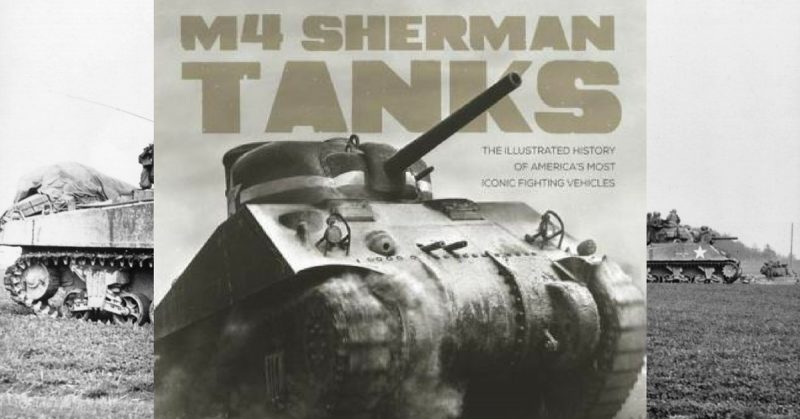A friend of mine has got back into model making. It is something I gave up a long time ago and only resumed for a short time when my son was a young lad. My mate asked me to do a detailed photo walk-round of a particular variant of a tank he plans to build in small scale. It is one of the most recognisable armoured vehicles of World War II. Look up the word icon in any dictionary and you will read it can be a person or thing worthy of veneration. Ladies and gentlemen, I give you the M4 Sherman tank.
This book has been tempting me from afar for a wee while ever since it appeared in the publisher’s catalogue. I am pleased to tell you the finished article is well worth the wait. Michael E. Haskew takes us through the development and service history of the mighty Sherman during World War II and beyond into relatively recent history. He starts by looking at tanks in general, and we go back to Lincoln in 1916 with the introduction of the Mk1 Male, the first practical design to see action. He continues with other important types including the little Renault FT17 and the Whippet before moving on to developments between the wars with the Christie suspension and other breakthrough systems. While all this is perfectly sensible and the roles of Patton, Adner Chaffee, and others are essential to the tank story; it the M4 we have come to see, and you will not be disappointed.
We are treated to a history of the tank and see it in many forms and working for a range of different nations. The importance of the Sherman to my own country cannot be underestimated. At the time of its introduction, the M4 was head and shoulders above any medium tank built here in the UK. It was reliable, rugged and practical and while we know the design had its faults; the Sherman remains something of an everyman in the tank family tree. To underscore my point about the tank’s place in the UK, it is fair to mention that Michael the oldest surviving Sherman in the world is on display in the Tank Museum. How marvellous it would be to see him running again.
For me, some of the best elements of this book come in the history of how the Sherman was designed and built. The factory scene images showing production lines and components in detail are fascinating. Images of wheels, springs and much more besides give us a glimpse of just how much effort went into tank production. Scenes of men refurbishing Shermans show how functional the tank proved to be.
Rising out of the shallow end of the tank park I have to tell you this book has been put together really well. The author packs it with detail but doesn’t get bogged down in it. Other books can look at every nut and track pin, and I will be just as happy to see them, but this one takes in the broad and sometimes narrower history and keeps it all in line. We travel from the factory floor to the World War II battlefields of Europe, Africa, and Asia; moving on remorselessly to Korea, the Indian sub-continent and further afield. The author treats this gazetteer of tank warfare with due care and attention. I am impressed.
There is enough for the nuts and bolts anorak and the more general reader. I would pitch myself somewhere in the middle, and I have learned a great deal from it. I don’t know about you, but I often get lost in the maze of variants and their designations. But for me, a Sherman is a Sherman. I am happy seeing any of them. If you visited my house, you would find a big print of an Easy Eight Sherman by Nicholas Trudgian hanging in the hall. My daughter hates it, but I am quite content to leave visitors in no doubt where my affections lie. Mr. Haskew has done much to confirm my love for Shermans, notwithstanding the five broken bones I suffered slipping off one a couple of years ago.
We’ve seen a few books from this author before, but I would suggest this is his biggie, the one every tank lover will want. It is crammed with wonderful archive photography, and the text flows well and does not overpower. The design style used to make this book enhances the history and I am pleased to see nods to culture with film posters adding to the bigger picture. These aspects cement the Sherman’s iconic status.
This summer saw me on the road with a couple and those moments are to be treasured. Driving on a country road with a Sherman or two hanging off your back bumper is something never to be forgotten. There were three out at Tankfest and while there were plenty of other exotica to enjoy, it is the Sherman that draws me, even more so than the Bovington’s feted Tiger. I have spilled perfectly good gin over one and really don’t mind. I’ve been working on an archive photography book of my own, and I found myself promising the publisher it wouldn’t be filled with pictures of Shermans. As it is, I sneaked in as many as possible.
The M4 may have been a mass produced workhorse compared to the distinctly more complicated Panther and Tiger it struggled to beat on the battlefields of Europe, but it was the war-winning weapon. It was a testament to American industrial might and magic while being a monument to the men of many nations who fought in them to defeat the Axis powers. This book celebrates it all and is another ‘must have’ for your bulging bookshelves.
Reviewed by Mark Barnes for War History Online

M4 SHERMAN TANKS
The Illustrated History of America’s Most Iconic Fighting Vehicles
By Michael E Haskew
Voyageur Press
ISBN: 978 0 7603 5030 0
